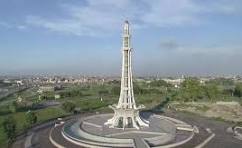Minar-e-Pakistan
located in Lahore, Pakistan, is a prominent national monument that holds historical significance for the country. This iconic structure was built to commemorate the Lahore Resolution, which was passed on March 23, 1940, and played a pivotal role in the creation of Pakistan.
The Lahore Resolution, also known as the Pakistan Resolution, was a key moment in the struggle for independence from British rule in India. During the annual session of the All-India Muslim League in Lahore, the resolution was passed, demanding the creation of an independent Muslim state. This resolution eventually led to the establishment of Pakistan in 1947.
Minar-e-Pakistan was designed by architect Nasreddin Murat-Khan and was constructed between 1960 and 1968. The monument stands in Iqbal Park, near Circular Road, and it has become a symbol of the Lahore Resolution and the birth of Pakistan. The tower itself is composed of four platforms, with a height of about 70 meters (230 feet). The base is designed in the shape of a flower, symbolizing the growth and blossoming of the nation.
Visitors to Minar-e-Pakistan can explore the surrounding park and learn more about the historical events that led to the creation of Pakistan. The site is often used for public gatherings, celebrations, and events related to national importance. The minaret also offers panoramic views of Lahore, making it a popular destination for both locals and tourists
Design
The tower reflects a mix of Mughal/Islamic and cutting edge architecture. The tower was planned and administered by, Nasreddin Murat-Khan, a Russian-born Pakistani modeler and gracious engineer. The minaret gives a all encompassing see to guests who can get to the best by climbing up the stairs or by implies of an elevator. The tower base is molded like a blossom.
The range encompassing the landmark is secured with parks and blooms. The area is frequently utilized for political and religious occasions. It is additionally known as the “Freedom Tower of Pakistan”. Structure The landmark sits on a plinth.
Structure
The base is almost 8 meters above the ground. The tower rises almost 62 meters on the base, and the entire tallness of the Minar is around 70 meters over the ground. The unfurling petals of the flower-like base are 9 meters tall. The distance across of the tower is approximately 9.75 meters.
The platform is built of designed tiles, and faces Badshahi Mosque. The base comprises of four stages. To symbolize the humble starting of the battle for opportunity, the primary stage is built with uncut stones from Taxila, the moment stage is made of hammer-dressed stones, and the third stage is made of chiselled stones. Cleaned white marble utilized for the fourth and last stage delineates the success of the Pakistan Movement. The structure employments the symbolism of bows and stars, signs that symbolize the culture of Pakistan, so also seen within the National Flag.
Mr. Mukhtar Masood, a productive essayist and the then–deputy commissioner of Lahore, was one of the members of the Building Committee for the tower.
Inscriptions
At the base, there are botanical engravings on ten merging white marble commemorative plaques. The engravings incorporate the content of the Lahore Determination in Urdu, Bengali and English, as well as the Delhi Resolution’s content, which was passed on 9 April 1946. On diverse plaques, Quranic verses and 99 names of Allah are engraved in Arabic calligraphy. Other critical engravings included on the landmark are the National Song of devotion of Pakistan in Urdu and Bengali, passages from the addresses of Muhammad Ali Jinnah in Urdu, Bengali and English; and a number of composed by Allama Iqbal.
Construction
Unique Establishment Stone Of Minar-e-Pakistan Construction The establishment stone was laid on 23 Walk 1960. Development took eight a long time, and was completed on 21 October 1968 at an evaluated taken a toll of Rs 7,058,000. The money was collected by forcing an extra charge on cinema and horse dashing tickets at the request of Akhter Husain, representative of West Pakistan.
Significance
Minar-e-Pakistan is considered the national insignia of Pakistan, and an expression of post-colonial national identity.
Notable visits and events
Eminent visits and events On February 21, 1999, Indian PM Atal Bihari Vajpayee got to be the primary Indian pioneer to visit Minar-e-Pakistan (past Indian state visits to Pakistan had not included a visit to Lahore). Vajpayee’s visit was compared to Nixon’s visit to China in terms of significance. Minar-e-Pakistan has served as the area for a number of rallies.The energizes have regularly caused harm to the encompassing vegetation, concurring to the Parks and Cultivation Specialist. In 2014, the Punjab government considered forbidding any political or non-political huge gatherings




